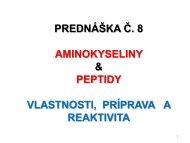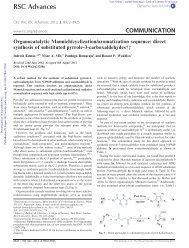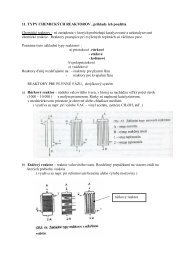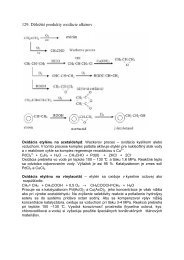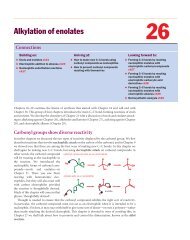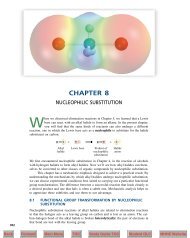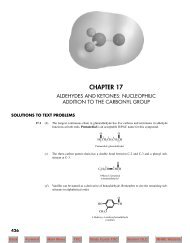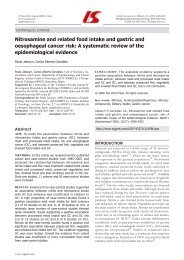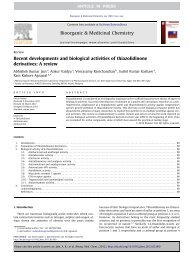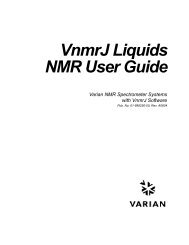NASÝTENÉ HETEROCYKLICKÉ ZLÚČENINY
NASÝTENÉ HETEROCYKLICKÉ ZLÚČENINY
NASÝTENÉ HETEROCYKLICKÉ ZLÚČENINY
You also want an ePaper? Increase the reach of your titles
YUMPU automatically turns print PDFs into web optimized ePapers that Google loves.
<strong>NASÝTENÉ</strong><br />
<strong>HETEROCYKLICKÉ</strong><br />
<strong>ZLÚČENINY</strong><br />
1
Nomenklatúra nasýtených N-, O-, S-heterocyklov<br />
- Dusíkaté (cyklické amíny)<br />
- Kyslíkaté (cyklické étery)<br />
- Sírne (cyklické sulfidy)<br />
H<br />
N<br />
aziridín<br />
O<br />
H<br />
N<br />
azetidín<br />
O<br />
H<br />
N<br />
pyrolidín<br />
H<br />
N<br />
piperidín<br />
oxirán oxetán THF THP<br />
S<br />
S<br />
O<br />
tiirán tietán THT<br />
S<br />
O<br />
H<br />
N<br />
azepán<br />
2
Prírodný výskyt a biologická aktivita<br />
nasýtených heterocyklických zlúčenín<br />
3
5- a 6-článkové dusíkaté heterocykly<br />
Pyrolidín, piperidín, morfolín a piperazín<br />
pK HA 11.27<br />
(Et 2NH: pK HA 11.02)<br />
H<br />
N<br />
pyrolidín<br />
H<br />
N<br />
O<br />
morfolín<br />
H<br />
N<br />
piperidín<br />
H<br />
N<br />
N<br />
H<br />
piperazín<br />
pK HA 11.12<br />
(Bu 2NH: pK HA 11.3)<br />
pKHA 9.28 pKHA1 9.83<br />
pKHA2 5.56<br />
4
5- and 6-Membered nitrogen heterocycles<br />
Morpholine & Piperazine – Reactivity<br />
• Morpholine and piperazine are cyclic secondary amines acting as nucleophiles in Ad N and S N reactions.<br />
• Morpholine, for example, is acylated with 3,4,5-trimethoxybenzoyl chloride to the drug trimetozine.<br />
(Ad N-E)<br />
Trimetozine (Opalene, Trioxazine)<br />
Tranquilliser, myorelaxans<br />
• N-methylpiperazine can be alkylated in an S N1 reaction to give the travel-sickness drug cyclizine.<br />
(S N1)<br />
Cyclizine (Antivert, Bonine)<br />
Antihistamine drug<br />
5
5- and 6-Membered nitrogen heterocycles<br />
Pyrrolidine – Reactivity<br />
• The addition of pyrrolidine to aldehydes and ketones leads to enamines, the valuable enol equivalents.<br />
• Enamines formed from pyrrolidine (and piperidine ) are particularly stable, because pyrrolidine<br />
(and piperidine) are rather more nucleophilic than comparable acyclic amines such as diethylamine.<br />
E +<br />
E<br />
6
Saturated N-heterocycles – Amines, but more nucleophilic<br />
• In general, the cyclic amines are rather more nucleophilic than comparable acyclic amines.<br />
• The alkyl substituents, being tied back into a ring, are held clear of the nucleophilic lone pair,<br />
allowing it to approach an electrophile without any hindrance – it is clearly a steric effect.<br />
DABCO – 1,4-diazabicyclo[2.2.2]octane 7
Synthetic utility of DABCO – Morita-Baylis-Hillmann reaction<br />
• The coupling of an activated alkene with an aldehyde catalysed by a tertiary amine to give an allylic alcohol – MBH reaction.<br />
• In addition to DABCO, additional nucleophilic amines such as DMAP and DBU as well as phosphines catalyse this reaction.<br />
• Protic additives like methanol, triethanolamine, formamide, and water also accelerate this atom-economical MBH reaction.<br />
8
The mechanistic update of MBH reaction<br />
• There are two alternative proposals focusing on details regarding the proton migration in the intermediate (5).<br />
• The viewpoints differ in the manner of deprotonation, and to date this question has not been fully resolved.<br />
In fact, recent ESI-MS studies provide strong experimental evidence that both mechanisms are possible...<br />
McQuade et al.:<br />
Org. Lett. 2005, 7, 147<br />
Aggarwal et al.:<br />
Angew. Chem., Int. Ed.<br />
2005, 44, 1706.<br />
9
Morita-Baylis-Hillman adducts - Biological activities<br />
Examples of compounds prepared from MBH adducts and its biological activities.<br />
10
CNS-active saturated N-heterocycles<br />
• The exposed nature of the nitrogen atom in cyclic amines means that nitrogen heterocycles<br />
are very frequently encountered in drug molecules, particularly those operating on the CNS.<br />
morphine<br />
heroine<br />
Papaver somniferum<br />
Erythroxylum coca<br />
codeine<br />
cocaine<br />
11
Sterically hindered piperidines – Non-nucleophilic bases<br />
• But the ring can also be used as a support for adding substituents that hinder the nitrogen’s lone pair.<br />
• Just as the N-atom of piperidine is exposed, the nitrogen atom of 2,2,6,6-tetramethylpiperidine (TMP)<br />
nestles deep in a bed of methyl groups. The lithium salt of TMP (LiTMP) is an analogue of LDA, a base<br />
that experiences enormous steric hindrance that can be used in situations where LDA usually fails.<br />
LDA = Lithium Diizopropyl Amide<br />
(pKa = 36 in THF)<br />
(pKa = 37)<br />
12
3- and 4-Membered nitrogen heterocycles<br />
Aziridine & Azetidine – Reactivity<br />
• Aziridine (b.p. 56°C) and azetidine (b.p. 62°C) are volatile, but stable saturated N-heterocycles.<br />
• Aziridine can be acylated by treatment with an acyl chloride, but the initial product is not stable.<br />
The ring opens with attack of Cl - , a relatively poor nucleophile, and an open-chain amide forms.<br />
(pK HA 8.0)<br />
• However, when the reaction is done in the presence of a base, removal of the proton leads<br />
immediately to the neutral acyl aziridine, which is stable.<br />
13
Synthetic utilisation of aziridine ring opening<br />
• Alkylation of aziridine in base gives the N-substituted aziridine, but a second<br />
alkylation leads to a cationic aziridinium salt that opens immediately to the<br />
useful bromoamine. In this case, the product is an intermediate in the<br />
synthesis of two natural products, alkaloids sendaverine and corgoine.<br />
Corydalis aurea<br />
14
Synthesis of saturated N-heterocycles – Comparison of cyclisation rates<br />
15
Reasons for the different rates of N-cyclisations<br />
Ring strain – Enthalpy<br />
rgy<br />
16
Reasons for the different rates of N-cyclisations<br />
Reactive conformers – Entropy<br />
17
Reasons for the different rates of N-cyclisations<br />
Summary<br />
18
Diminishing the DS # – Thorpe-Ingold effect<br />
• The substitution of alkyl/aryl groups for hydrogens on a -CH 2- chain leads to a sterically induced reduction of<br />
the internal angle of the carbon chain, which brings reacting centers closer together – Thorpe-Ingold effect.<br />
• This compression was confirmed by X-ray and was argued to be sufficient to account for the rate variations.<br />
• Thorpe-Ingold effect in operation - the comparison of relative rates of S N2 cyclisations of 4-bromo-pentenylamines.<br />
19
Diminishing the DS # – Thorpe-Ingold effect<br />
Hypothesis of reactive conformers<br />
20
Diminishing the DS # – Thorpe-Ingold effect<br />
Steric compression and/or solvent effect?<br />
• The chlorohydrins (1-3) undergo base-catalysed cyclisation to respective oxiranes with relative rates of 1 : 21 : 252.<br />
• Traditionally, the observed acceleration has been attributed to the Thorpe-Ingold effect – i.e. steric compression.<br />
• However, gas-phase quantum mechanical calculations showed that there is little difference in intrinsic reactivity for<br />
(1-3). Instead, subsequent consideration of continuum hydration reproduced well the observed reactivity pattern.<br />
• The principal origin of the rate enhancement on going from (1) to (3) arises from increased steric hindrance to<br />
hydration of the nucleophilic oxygen atom with increasing a-methylation – i.e. Thorpe-Ingold is a solvent effect.<br />
21
Heterocyclisations – Chemoselectivity issues<br />
• In the intermolecular reaction, the amine adds to the C=C bond of the a,b-unsaturated ester via conjugate 1,4-addition.<br />
• However, an analogous intramolecular cyclisation proceeds via direct 1,2-addition of the amine to the C=O bond. WHY?<br />
The answer lies in the orbital alignment which is then expressed in the BALDWIN RULES<br />
22
Classification of heterocyclisations – Baldwin’s rules<br />
The ring being formed has three (3) members,<br />
the breaking C-Br bond is outside the new ring (exo),<br />
the carbon atom carrying Br is a tetrahedral (sp 3 ).<br />
The ring being formed has five (5) members,<br />
the breaking C=O bond is outside the new ring (exo),<br />
the carbon atom being attacked is a trigonal (sp 2 ).<br />
The ring being formed has six (6) members,<br />
the breaking C≡C bond is inside the new ring (endo),<br />
the carbon atom being attacked is a digonal (sp).<br />
23
Baldwin’s rules – A rationale behind<br />
• Nucleophiles have to approach the electrophilic sites on single, double or triple bonds in very specific directions in<br />
order to overlap effectively with the s * - and/or p * -antibonding orbitals. The requirements are summarised below:<br />
24
Useful selection of Baldwin’s (empirical) rules<br />
s<br />
25
Useful selection of Baldwin’s (empirical) rules<br />
26
Baldwin’s (empirical) rules – Exceptions<br />
• Baldwin’s rules are only empirical guidelines describing the kinetic favourability of a cyclisation.<br />
• When a reaction is thermodynamically very favourable and there is no other possible pathway,<br />
5-endo-trig reactions can take place – e.g. the formation of a cyclic acetal (dioxolane) via cation.<br />
In fact, cations frequently disobey Baldwin’s rules. Exceptions are also reactions in which atoms<br />
such as sulfur are included in the ring. The following 5-endo-trig cyclisation works, because C–S<br />
bonds are long (1.82 Å), and the empty 3d orbitals of sulfur can interact with the C–C p* orbital.<br />
27
Baldwin’s (empirical) rules – Summary<br />
28
Sir Jack E. Baldwin (1938)<br />
PhD. :<br />
1964, Imperial College, London (Prof. Derek Barton)<br />
Profesor organickej chémie:<br />
1963-1969 Imperial College, London<br />
1969-1978 MIT, Cambridge, USA<br />
1978-2005 Oxford University, UK<br />
Ocenenia:<br />
Fellow of The Royal Society (1978)<br />
Povýšený do šľachtického stavu (1997)<br />
Vypracoval súbor empirických pravidiel popisujúcich cyklizačné reakcie.<br />
Položil základy biomimetickej totálnej syntézy prírodných látok.<br />
29



